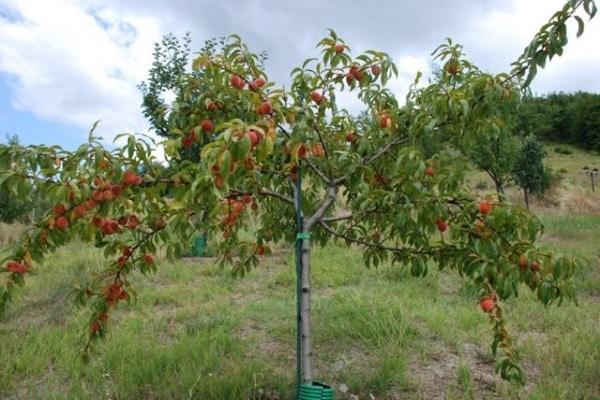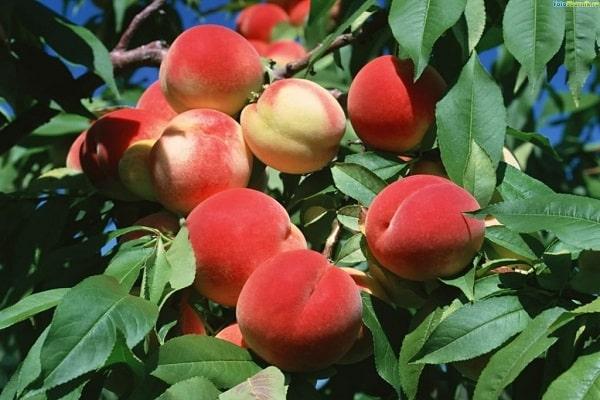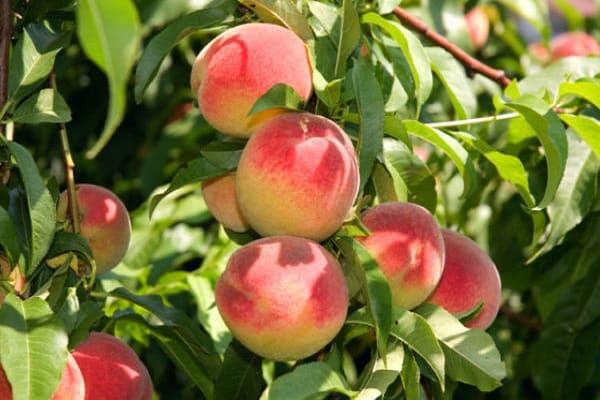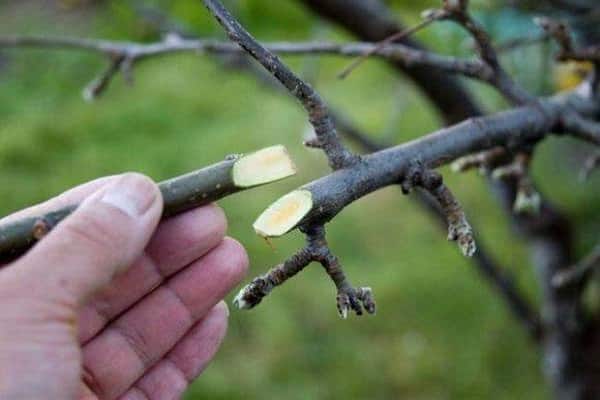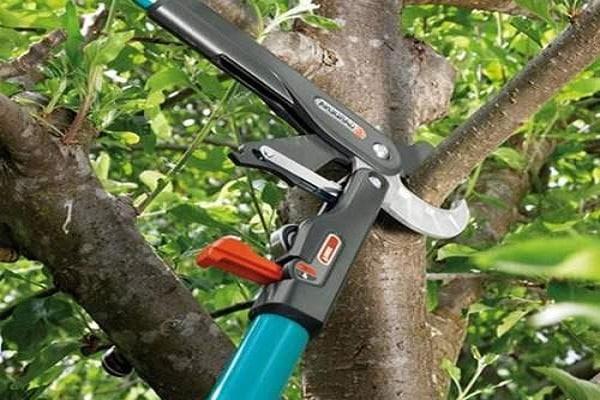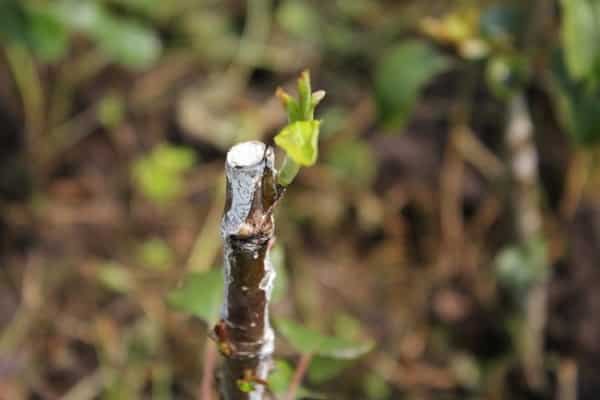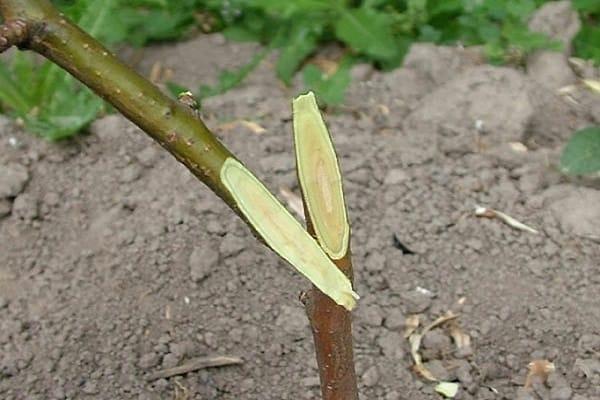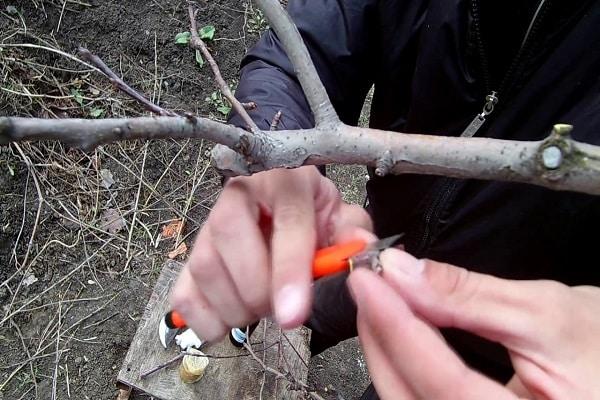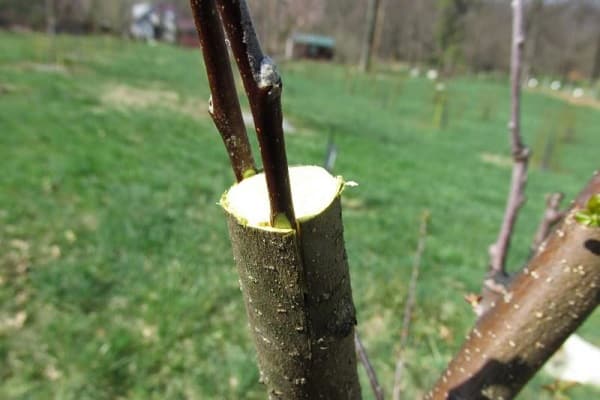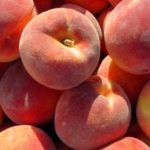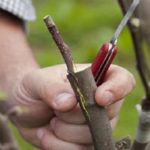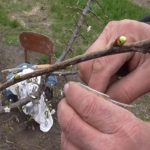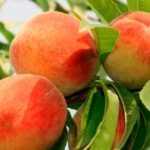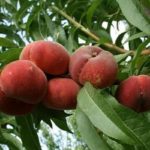It is no more difficult to graft a peach than an apple or pear tree. The technology and methods are the same. To carry out the operation, you need to acquire a high-quality tool and learn how to make even cuts at the right angle and the required length.
- Goals and objectives of peach grafting
- Suitable timing
- Spring
- Summer
- Autumn
- Choosing the best rootstock for peach
- For apricot
- To the plum
- For cherry plum
- For almonds
- Rules and preparation of scion and rootstock
- What tools and materials will be needed
- Common grafting methods
- Improved copulation
- Conventional copulation
- Budding in the butt with a kidney
- Budding into the rootstock crown T-shaped
- For the bark
- Tree care after grafting
Goals and objectives of peach grafting
Grafting is one of the methods of propagation of stone fruit crops.With its help, seedlings with certain varietal characteristics are obtained. This technique allows you to rejuvenate an aging tree and obtain a new variety.
Gardeners, using frost-resistant scion, grow peaches with increased winter hardiness. Some, saving space, graft cuttings of different varieties of crops onto one tree. This allows you to grow a crop of fruits of different tastes in a small garden.
Suitable timing
Peaches are grafted at any time, except winter, but with an eye to the climatic conditions of the region. The timing of the work is affected by the age of the tree and the method.
Spring
In the spring, peach is grafted with cuttings using the copulation and budding method. According to gardeners, this is the best time to work. Weather and active sap flow promote rapid healing of postoperative wounds. Copulation (budding) is carried out from March 10-15 to April 30.
Frost causes the scion to reject. Therefore, vaccination operations are carried out after stable warm weather has established. In late spring, peach is grafted after harsh winters. It takes time to assess the degree of freezing of the rootstock.
Summer
In July or June, peach is grafted into the crown using the budding method. It can be held in August, but only at the very beginning. In order for the shield to take root successfully, the bark on the tree must lag behind. The engraftment process lasts 2-3 weeks.
Gardeners distinguish two categories of summer grafting:
- early summer - from June 1 to June 10;
- summer - from July 10 to July 30.
Autumn
The scion will not have time to take root before frost, so in winter it will freeze out with one hundred percent probability. Gardeners do not graft peaches in the autumn.
Choosing the best rootstock for peach
The choice of rootstock determines which tree will grow, its yield, ripening time, early fruiting, and fruit size. The table provides information on what can be grafted onto a peach.
| Name | Rootstock (type) | Description |
| OP 23 23 | Semi-dwarf | Hybrid |
| Spring flame | Medium height | Hybrid obtained from crossing Chinese plum and cherry plum |
| Eureka 99 | Medium height | Hybrid of cherry plum + cherry plum |
| Fortune | Medium height | Hybrid Chinese plum + peach |
| VSV 1 | undersized | Hybrid felt cherry + cherry plum |
| VVA 1 | Semi-dwarf | Hybrid form (cherry plum + felt cherry) |
They are most often vaccinated in central Russia. People often graft peach onto peach. At the same time, they obtain marketable and tasty fruits. Trees on peach rootstocks show consistently high yields.
For apricot
This type of rootstock is suitable for beginners. Experienced gardeners believe that there are no problems with survival. Wild apricot is usually used. This graft guarantees:
- stable yield;
- no influx;
- survival rate 100%.
To the plum
Plum is used as a rootstock when they want to increase the resistance of peach to low temperatures. For the rootstock, choose a healthy tree of a frost-resistant plum variety.
For cherry plum
This is the best type of rootstock. On its basis, peach seedlings are grown that are resistant to infections (virus, fungus). Peach fruits grafted onto cherry plum have a more pronounced, interesting taste. This type of rootstock has one drawback - numerous basal shoots. It has to be cut out regularly. It takes nutrients from the tree.
For almonds
This option is suitable for peach orchards in the south. Such seedlings can grow and bear fruit only in warm climates.
Rules and preparation of scion and rootstock
For the rootstock, choose cherry plum, plum, and apricot trees no older than 2 years. Those with a barrel diameter of no more than 10 mm are suitable.Cuttings (scion) are harvested in the fall, before the first frost. There is a simple explanation for such harvesting times - in winter, some of the annual shoots may freeze. Early in the spring you may not understand this. Frozen cuttings do not take root well. When preparing the scion, use the following rules:
- take the middle part of the shoot with a diameter of at least 5 mm;
- a piece 15 cm long is cut out;
- there should be 10 healthy buds on the branch.
In winter, the cuttings are stored in the refrigerator, sealed in a bag. Recommended storage temperature 0-2 °C. A large volume of branches is stored outside in thick snow. First, they are covered with a layer of sawdust 30 cm thick.
The cutting may dry out during storage. Before vaccination, his condition is checked. To check, it is bent. Flexibility speaks of its viability. A high-quality cutting is kept in water for 1-2 days before grafting.
What tools and materials will be needed
The operation must be done quickly with sharp, clean instruments. For a good result, the cuts need to be smooth, without burrs, chips or fringes. Gardeners use the following set of tools to graft peach trees:
- pruner;
- knife;
- wood hacksaw (for old trees).
Among the auxiliary materials you need to have on hand: PVC film, electrical tape, gauze (bandage), garden varnish, newspapers. Paper is needed in the summer to protect the grafting site from the hot rays of the sun.
Experienced gardeners, who often graft fruit and stone fruit crops, purchase special garden pruners. They are not cheap, but they allow you to make even grooves of the desired shape and size.
Common grafting methods
There is no need to come up with new peach grafting methods. The methods have long been known, you just need to master them.Any variety can be propagated from green cuttings. Self-rooted peach seedlings are grown using this vegetative method.
Root the cuttings in a substrate consisting of compost and soil from the garden. They fill the container. The top layer is sand. The planted cuttings are covered on top with a transparent 1 liter jar. Care comes down to watering and ventilation. After the roots have formed, the seedling is planted in a greenhouse or in a garden bed.
Improved copulation
This method guarantees a high survival rate. Improved copulation is carried out in the spring from the end of March to mid-April. You need 1-2 year old shoots of the same diameter.
Cuts on the scion and rootstock are made at an acute angle (30°), of the same length. It should be equal to 3 diameters. The upper part of the cutting is cut at a right angle. 3 or 4 buds are left on the scion.
To increase the contact area, longitudinal cuts about 10 mm long are made at the corners of the cuts. The resulting tongues wind each other. The junction area is wrapped with electrical tape and covered with garden varnish.
Conventional copulation
Beginners learn to graft a peach using this method. It's quite simple. Performed according to the following scheme:
- The rootstock is cut at an angle of 30°;
- a similar cut is made on the cutting, placing it directly under the lower bud;
- connect both parts;
- wrapped with electrical tape;
- coated with varnish.
The wrapping is removed when the shoot begins to grow and reaches a length of 25 cm. The wood on it will have time to mature before winter. In autumn, fruit buds will form on it.
Budding in the butt with a kidney
The method is quite complicated for beginners. Experienced gardeners use it. The operation is carried out in early April. A scutellum with one dormant bud is cut from a cutting prepared in the fall.They try to keep its length about 30 mm.
At the grafting site, a piece of bark of the same size is cut off. Apply a shield to this place and secure it with electrical tape. Remove the winding after 30 days. The operation site is coated with garden varnish.
Budding into the rootstock crown T-shaped
This method is considered the simplest. An incision (T-shaped) is made on the rootstock (bark) using a special pruning shears or a sharp garden knife. Try not to damage the wood. A shield about 25 mm long is cut from the cutting: 15 mm above the bud, 10 mm below the bud.
The layer of wood should be minimal. The shield is inserted into the T-shaped incision as quickly as possible. From 2 to 3 shields can be grafted onto 1 crown branch, maintaining a distance of 5-7 cm between them. Film is used for tying.
They remove it exactly after a month, and cut out the ungrafted shoots. The vaccination site is marked. Next spring, retreating 5-10 mm from it, the branch is cut off.
For the bark
Old trees are grafted onto the bark. They are rejuvenated in this way. Vaccination for bark is carried out from the end of March to April 10-15. The trunk or thick skeletal branch of a peach is cut off at a right angle.
Prepare several cuttings. They cut off the lower part at 30°, leave 3-4 buds, cut off the top. The bark of the rootstock is cut from the cut downwards by 5 cm. Shoots are inserted into the resulting cuts. The vaccination is fixed with electrical tape.
Tree care after grafting
After 4 weeks, the covering bandage is removed. The operation site is coated with a layer of varnish. A list of activities that will help the tree withstand the stress caused by grafting:
- control the soil moisture in the root circle, water at least once every 2 weeks, use 1-2 buckets of water per tree;
- control the appearance of growth below the grafting site, it is regularly cut out;
- carry out an inspection of the above-ground part, treat it with insecticides and fungicides if pests or symptoms of a fungal disease are detected.
At first, novice gardeners make mistakes. They work with dirty, unsharpened tools. They do not follow the necessary rules for caring for the grafted tree. They forget to remove the wrapping in time and do not protect the surgical site from the sun. Budding is done on the south side of the trunk. There will be no problems if you avoid repeating these mistakes and strictly adhere to the correct technology.


